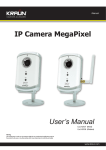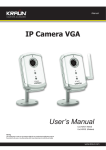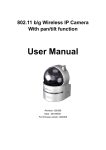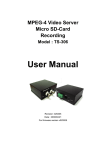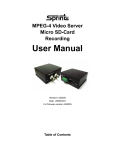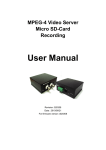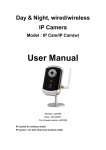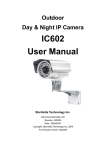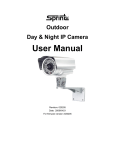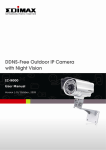Download Kraun KW.05 surveillance camera
Transcript
Manual IP Camera VGA Pan/Tilt Wireless User’s Manual Cod. KW.05 Warning The manufacturer is under no circumstances liable for any unauthorised modifications made to the product by the user or any other parties which may compromise its conformity and safety. www.kraun.com Manual Table of Contents 1. Introduction.................................................................................................................3 2. Hardware description and quick installation/usage................................................4 2.1. Major hardware components...................................................................................................4 2.2. Quick installation and usage....................................................................................................5 2.3. Wireless connection.....................................................................................................................9 3. Web configurations...................................................................................................10 3.1. Information...................................................................................................................................11 3.2. Video Display................................................................................................................................12 3.3. Network..........................................................................................................................................13 3.4. WiFi security..................................................................................................................................14 3.5. Advanced Network....................................................................................................................16 3.6. Video Settings..............................................................................................................................17 3.7. 3GPP/RTSP settings....................................................................................................................19 3.8. Email/ftp alarm............................................................................................................................20 3.9. DI/DO settings.............................................................................................................................22 3.10. NAS settings.................................................................................................................................23 3.11. SD-Card settings.........................................................................................................................25 3.12. Scheduling....................................................................................................................................27 3.13. Led Display Control....................................................................................................................28 3.14. Date/Time......................................................................................................................................29 3.15. Admin.............................................................................................................................................30 3.16. Upgrade.........................................................................................................................................31 3.17. Reboot............................................................................................................................................32 3.18. Safe Mode......................................................................................................................................33 3.19. Set to factory default.................................................................................................................34 4. Features and specifications......................................................................................35 4.1. Features..........................................................................................................................................35 4.2. Specifications...............................................................................................................................36 5. FAQ.............................................................................................................................38 2 www.kraun.com Manual 1.Introduction The Pan/Tilt IP Camera is designed with the “user-friendly” idea deep in mind. The user can install the IP camera easily on his/her home network and then access the IP Camera anywhere in the world through the accompanied video management software - KraunView program without setting some complicated DNS name or changing the router’s settings. It’s just a plug & play action. With pan/tilt support, users can monitor the video in a much larger viewing angle range. For indoor surveillance and remote monitoring, the IP camera provides the best image quality in its class, and excellent performance. The Pan/Tilt IP Camera also provides the best bandwidth efficiency, it offers 640x480 resolution, 30 fps frame rate, real MPEG4 image compression ability. The built-in microphone enables remote users to not only view, but also listen for additional monitoring options. With 3GPP/ISMA support, users can see the video of the IP camera on any 3G mobile phone anywhere, anytime. The big difference is that there is software for downloading to the mobile phone so that the fixed IP address is not needed for the IP camera. The video settings including frame rate, resolution and bandwidth could be different for PC monitoring and mobile viewing. With pan/tilt support, users can monitor the video in a much larger viewing angle range. The NAS storage function can easily turn any NAS device to a NVR device. The schedule function provides full scheduling of email/ftp sending, motion detection and NAS recording event. With the built-in Web server, the IP Cameras can also be managed from a standard web browser on a Windows computer. With the ActiveX support, users can also see the video display on the Windows IE browser. The Pan/Tilt IP Camera provides both wireless IEEE 802.11 b/g and wired Ethernet network interfaces for flexible installation. It supports the WEP and WPA (Wi-Fi Protected Access) security modes to provide the best security for wireless networks. The Pan/Tilt IP Camera provides motion detection function. Users can easily setup this function and receive the notification with the snapshot images through email and/or ftp when some motion events are detected. The Pan/Tilt IP camera is ideal for securing small businesses, home offices and residences over a local area network and/or the Internet. The differences It’s very easy to see the video of the Pan/Tilt IP Camera, you only need to key in the ID/Password of the IP CAM any where in the world, you do not need to remember the IP address or domain name or DDNS name or port number. And you do not need to modify the settings(like port mapping, fixed IP, DDNS, virtual server) of the NAT/router devices, it’s just a plug & play usage. So, the differences are the followings: • Public IP address needed ?No • Dynamic DNS needed ?No • Port mapping in router?No • Virtual server in router ?No • UPnP support in router ?No • What’s needed ? ID and Password 3 www.kraun.com Manual 2.Hardware description and quick installation/usage The IP CAM is designed to be very easy to install and use. First, let’s see the major components of the IP CAM products. 2.1. Major hardware components. The major components on the front panel of the IP CAM products are the built-in microphone, lens and LEDs : 1. Microphone – for receiving the audio/voice. Effective distance is about 5 meters. 2. Lens – the lens is inside the mask and the focus of the lens is fixed, you do not need to spend time to adjust the focus, the effective focus range is from 30cm to infinity. 3. Status indication LED (red) – this LED is to indicate the Internet connection status. When the Internet connection is connected, the LED will be constant red light. If there is any Internet connection problem, the LED will be blinking red light. 4. Ethernet indication LED (blue) – this LED is to indicate if the Ethernet link is ok and packet traffic is sending/receiving. When the Ethernet cable is connected, the LED is constant blue light. When there is packet sending/receiving, the LED is blinking blue light. Figure 2-1: Major components in the front panel The major components on the back panel of the IP CAM products are the bracket screw jack, power jack, Ethernet jack and reset button: 1. Bracket screw jack – this is the position to screw in the bracket of the IP CAM. With the bracket, you can put the IP CAM on the desk, on the wall or on the ceiling. (Bracket not provided) 2. Power jack – this is the place to plug in the power adaptor. The power needed for this IP CAM is 5V/1.0A, please make sure you are using the correct power adaptor. 4 www.kraun.com Manual 3. Ethernet jack – this is the place to plug in the RJ45 Ethernet cable. When the Ethernet link is ok, the Ethernet indication LED on the front side will be blue light. 4. Reset button – this is the button to reset the IP CAM to default factory settings. You need to use a small stick like pencil or tooth stick to press the reset button for more than 3 seconds to enable the reset function. Usually when you forgot the administrator account, you will probably need to do this reset action to reset to the default factory settings. Please refer to section 3.19 for more details. 5. Wall mount – this is the place to hang the IP CAM on the ceiling or on the wall. 6. Antenna – this is the 802/11 b/g wireless antenna. 7. Digital I/O : one digital input and one digital output is provided to give users control to alarm speaker or to signal alarm detection. 8. Micro-SD card slot – for inserting the micro SD-Card. (support up to 16G bytes) Figure 2-2: Major components in the back panel 2.2. Quick installation and usage There are only three things that you need to do to see the video from the IP CAM. 1. Connect the IP CAM to the home/office network. 2. Install the KraunView software on the notebook/PC. 3. Key in the ID/password of the IP CAM(from the ID/Password card) on the KraunView, and then you can see the video. 5 www.kraun.com Manual First, Connect the IP CAM to the home/office network Please connect the IP CAM accessaries to the IP CAM body correctly, including the power adapter and Ethernet cable, as shown in Figure 2-3. And connect the other end of the Ethernet cable to the home network or office network. Usually, this Ethernet cable is plugged into a home NAT/router device or an Ethernet switch if in the office, as shown in Figure 2-4. Since the default settings of the IP CAM use DHCP function and very often there is a DHCP server on most of the Home/office network, the IP CAM should be connected to the Internet immediately. The Internet status LED is constant red light to indicate this good connection status. If the LED is blinking, please refer to section 3.3~3.5 to try other network settings. Figure 2-3: IP CAM connection diagram. Figure 2-4: Connect Ethernet cable to a switch/router. 6 www.kraun.com Manual Second, Install the KraunView software on the notebook/PC Please insert the installation CD into the CD-ROM drive in your notebook or personal computer (must be running Microsoft Windows OS). Execute the program KraunViewInstaller-xxx.exe on the disk. The program will pop-up some windows about the installation options, please press the “next” button to proceed with the installation. After the installation is complete, there will be a KraunView icon on the desktop of your computer screen, please execute this icon. The KraunView program will run immediately. Figure 2-5: The installation CD disk Third, Use KraunView program to see the video Figure 2-5 is the running window of the KraunView program. If the computer and IP CAM is connected to the same network, the IP CAM ID will be displayed in the “Auto Search” list. You can double click the “Auto Search” to search all the connected IP CAMs any time. The only thing left right now for seeing the video is to double click the IP CAM ID item in the “Auto Search” list. For example, if the IP CAM ID is 001-001-029, you can then double click the 001001029 item in the “Auto Search” list to view the video. A window asking for password input will pop up. Please key-in the password in your ID/Password card into this field and click “ok”. The video will then be displayed on the window. Figure 2-6: The ID/Password card Notice : 1. You can modify this play-video password by entering into the web configuration pages. Please refer to section 3.6 for more information. 2. You can also add the IP CAM into the CameraList in the KraunView software to have more convenient video display, please refer to the user manual of the KraunView software for more functions. 7 www.kraun.com Manual Seeing the video in a remote location After the IP CAM is installed and you can see the video from the KraunView software in the local network, it’s very easy to see the video in a remote location. All you need to do is add a camera item in the “CameraList” folder of the KraunView software, key in the IP CAM ID and Password(from the ID/Password card). And then double click this camera item. You will then see the Camera video immediately. No further NAT/router setting modifications are needed. Figure 2-7: Running window of KraunView program Figure 2-8: Pop-up play-video password window 8 www.kraun.com Manual 2.3. Wireless connection The IP CAM can also be connected to the home/office network through the 802.11 b/g wireless connection. There are only three things that you need to do to have the wireless connection: 1. Set the WiFi security settings on the web configuration page. 2. Test if the WiFi settings are correct. 3. Unplug the Ethernet cable. First, set the WiFi security settings on the web configuration page. Make sure there is a WiFi router or AP on your home or office network. Write down the WiFi security parameters used in this WiFi AP/router, including the SSID , security mode, encryption protocols and the “key” values. The supported WiFi security mode of the IP CAM is WEP(64 bits and 128 bits) and WPA-PSK(TKIP and AES). In most of the home/office WiFi environment, this is quite enough. The easiest way to set the WiFi settings on the IP CAM is through KraunView software. Right-click the searched IP CAM in the “Auto Search” list and click the “Web Configure” to open the login window of the IP CAM. Fill in all the WiFi security parameters you have written down. The WiFi configuration is complete now. Please refer to section 3.4 for more detailed description if needed. Second, test if the WiFi settings are correct You can now test if the above WiFi settings are correct. Click the “WiFi test” on the “WiFi Security” settings web page. The testing result will be displayed in less than 60 seconds. If the test is failed, please check the WiFi security parameters and test again. Third, unplug the Ethernet cable If the WiFi test is successful, you can then enable the WiFi connection by unplugging the Ethernet cable from the IP CAM. The IP CAM will detect the Ethernet cable unplugged condition and start the WiFi connection. After the WiFi is connected, the IP CAM will connect to the Internet immediately. Notice : 1. Please remember that the WiFi connection will use a different IP address, you will need to do the “Auto Search” function in the KraunView again to find the IP CAM again after the WiFi is connected. 2. If you want to switch back to the wired Ethernet connection, just plug in the Ethernet cable into the IP CAM again. Do not need to disable the WiFi function on the web pages. Figure 2-9: Unplug the Ethernet cable to enable the WiFi function 9 www.kraun.com Manual 3.Web configurations You can login into the web configuration page by directly key-in the IP address of the IP CAM or right-click the searched IP CAM in the “Auto Search” list of the KraunView software and click the “Web Configure” to open the login window of the IP CAM. Figure 3-1: Open the web configuration page from KraunView software The default login account is “admin”, leave the Password field empty. Figure 3-2: IP CAM Web configuration login page 10 www.kraun.com Manual 3.1. Information The first page of the web configuration of the IP CAM is the information page. You can see the model name/ firmware version, IP CAM ID, registration status, network type and current video settings( bandwidth, resolution) in this page. The IP CAM can be viewed remotely by the KraunView software only when the IP CAM is registered. If this IP CAM is not registered, please check the Ethernet wiring of your network environment. The “Network type” field displays the network connection(wired or wireless) and method(DHCP, PPPoE or static ip) the IP CAM is running. The “Video users” field displays the number of connected video viewing users. Figure 3-3: IP CAM Information page 11 www.kraun.com Manual 3.2. Video Display This display page allows you to view the video display and control the pan/tilt movement of the IP camera. For the first time use of this display on a computer, an activeX component will be automatically downloaded into the browser. This could take some time, depends on the internet speed. The component is downloaded from a public domain, so that the computer must be connected to the Internet. If you want to modify the video display screen size, please refer to section 3.6 for more details. Figure 3-4: Video display page Pan/tilt control: 1. Control by KraunView – this is to enable/disable the pan/tilt control function by KraunView software. 2. Speed – this is to control the pan/tilt moving step distance for each pan or tilt movement, fast means larger step movement. 3. Pan – click this button will let the IP CAM do one horizontal pan scan movement. 4. Tilt – click this button will let the IP CAM do one vertical tilt scan movement. 5. Patrol control – you can set up to 5 patrol points that will let the IP CAM to patrol through these patrol points. To set the patrol point, first move the IP CAM to the desired view position by clicking the different arrow buttons, and then press the “position” button of the specific patrol point. The (x,y) axis values will be updated accordingly. You can click the (x,y) axis of the patrol point to direct the view to this specific patrol point directly. After the patrol points are set, you can click the “Patrol” button to start the patrol through these points one time. 6. Stay xx secs – this is the time for each patrol point to stay before going to next patrol point. 7. Patrol – click this button to start the patrol movement of the IP CAM. 8. Stop – this will stop the patrol movement. 12 www.kraun.com Manual 3.3. Network The Network page allows you to modify the network settings of the wired Ethernet. The default settings use DHCP to obtain an IP address automatically. In most of the home and office network environment, there is a DHCP server running. In this situation, by using this default settings, the IP CAM can work immediately in most of the time. If the Ethernet cable is unplugged, the IP CAM will lose connection. But as soon as the Ethernet cable is plugged in again, the IP CAM will obtain a new IP address immediately. Figure 3-5: Network settings page for DHCP function If the network environment does not support DHCP function, you will need to set the network settings of the IP CAM manually. Please fill all the fields including “IP address”, “Subnet mask”, “Default gateway” and “DNS server” to let the network work. All these settings must be correct for your network environment, otherwise the IP CAM can not work. The default setting is “Obtain an IP address automatically”. Figure 3-6: Network settings page for fixed IP address 13 www.kraun.com Manual 3.4. WiFi security You can use the wireless to connect the IP CAM to the network. If your network environment has a 802.11 b/g router or AP running, you can check the “Enable WiFi function” button to use the wireless. Figure 3-7: WiFi security disabled page In order to use the wireless network, you need to fill the following fields: 1. SSID – this is the ID of the wireless router or AP of your wireless network environment, must be set correctly. 2. Security mode – this is the security mode used in the wireless router or AP. Need to choose one of the three modes – None, WEP and WPA-PSK. 3. WEP : Wireless Encryption Protocol. 4. WPA : WiFi Protected Access. 5. PSK : Pre-Shared Key. 6. TKIP : Temporal Key Integrity Protocol. 7. AES : Advanced Encryption Standard. 8. WEP mode – when the WEP mode is chosen, you need also choose between 64-bit(5 char), 64-bit(10 hex), 128-bit(13 char) and 128-bit(26 hex) encryption mode, and then fill the WEP key correctly. 9. WPA-PSK mode - when the WPA-PSK mode is chosen, you need also choose between TKIP and AES encryption mode, and then fill the WPA-PSK key correctly. WPA2-PSK is also supported. But WPA Enterprise or WPA2 Enterprise is not supported. 14 www.kraun.com Manual All the fields in this page must be filled correctly with the same settings the wireless router or AP using. Figure 3-8: WiFi security enabled page You can click the “WiFi test” button to check if the IP CAM can connect to the wireless network for these settings. You will need to unplug the Ethernet cable to enable the wireless connection after the “WiFi test” is successful. You can click the “WiFi scan” button to scan for all the available access points nearby. If you want to define fixed IP address when using WiFi connection, please press the “IP address” button and key in your preferred IP address. After the setting and “Save&Apply”, do not need to restart the IP CAM to let the WiFi work, only need to unplug the Ethernet cable. The default setting is “Disable WiFi Function”. Figure 3-9: WiFi testing page 15 www.kraun.com Manual 3.5. Advanced Network In some special situation, your network environment only provides PPPoE connection(ADSL service), there is no NAT/router available. You will then need to set the PPPoE settings in the “Advanced Network” page. Only the PPPoE username and password are needed to let PPPoE work. After the “Save&Apply” button is pressed, the PPPoE function will work immediately. You can check the “Registration status” in the “Information” page to see if the IP CAM is registered using the PPPoE connection. Please be noticed that the DHCP or static IP settings in the “Network” page can work together with the PPPoE connection. Only that the PPPoE has higher priority, so, if the PPPoE is working, the IP CAM will use PPPoE to connect to the Internet. The default setting is “Disable PPPoE”. Figure 3-10: Advanced network settings page 16 www.kraun.com Manual 3.6. Video Settings The IP CAM is designed to provide high quality video for viewing from KraunView software. In this page, you cam modify some settings related to the video viewing: 1. Password(play video) – this is the password needed for viewing the video from the KraunView software. Together with the IP CAM ID, you can view the video of this IP CAM anywhere in the world through the Internet. 2. Internet speed – this is the Internet bandwidth of your network environment. Higher value will generate higher video quality. But if your internet connection can not provide more bandwidth than the specified value, the video quality could degrade. So, please key in a value that is lower than your internet bandwidth. 3. Select resolution & frame rate automatically – you can let the system select the suitable video resolution and frame rate automatically for you. The selection is based on the “Internet speed” value. This is the recommended default setting. 4. Resolution – there are three choices : 160x120, 320x240 and 640x480. If you decide to choose the value manually, you can choose one of the three values. But, please be noticed that if the Internet speed is slow(low value), high resolution(640x480) or frame rate could cause very bad video quality. 5. Frame rate – the video frame display rate. Higher value means faster movement and continuity in the video display. 6. Favor/Preference – choose between “Video motion” and “Image quality”. When the real bandwidth is not enough for the selected “Internet speed”, the system will need to degrade the video motion or image quality. This selection will decide if the user want to maintain the “video motion” or “image quality” when the internet speed is not good enough. 7. Brightness – the brightness of the video, lower value means darker display. 8. Sharpness – the sharpness of the video, higher value means sharper video. 9. Low light sensitivity – The low light sensitivity could be normal, high or very high. When the low light sensitivity is high, the system could see better video clearance under low light situation, but the moving object will not be very clear under this low light environment. Under very dark environment, set to “very high” will get better video clearance. The default value of this setting is “high”. 10. Video color – choose between “colored” and “black&white”. 11. Video flip – can do “normal” or “flip” video display, this is needed if the ip camera is hung on the ceiling or wall. 12. Outdoor/Indoor video – for better video display quality, modify this setting when taking indoor or outdoor video. The default setting is “Outdoor video”, in most cases, this is also ok for indoor usage. Under some special cases, there could be some strip lines on the video display when the IP camera is taking indoor video. In this situation, change the setting to “Indoor video” will solve the problem. Please also be noticed that in “Indoor video” setting, the video display of outdoor view is very vague. For indoor usage, if there is strong sun light into the room, please select the “Indoor+sun light” choice. 13. Enable/disable audio microphone – you can enable or disable the audio microphone on the IP CAM. If disable, there will be no voice on the KraunView video viewing. 14. Enable/disable time display on video – if enabled, the date/time of the system will be displayed on the left-upper corner of the video. 17 www.kraun.com Manual When this modification is “Save&Apply”ed, it works immediately, but all the connected video viewing users will be disconnected. Figure 3-11: Video settings page 18 www.kraun.com Manual 3.7. 3GPP/RTSP settings The IP CAM is able to be viewed from a 3G mobile phone, for detailed settings on the 3G mobile phone, please refer to Appendix E. Users can disable the 3G mobile access ability in this page. After the 3GPP/RTSP feature is disabled, no 3G mobile phone is allowed to access the video of the IP camera. When this is disabled, the rtsp stream with MPEG2 audio is still working, please refer to Appendix F for more details about rtsp stream with MPEG2 audio. When the 3GPP is enabled, the video frame rate, resolution and bandwidth for 3G mobile access could be set independently from the video settings for KraunView(PC) access. The maximum allowed resolution is 352x255 and maximum allowed bandwidth is 256 kbps. When the audio is enabled for both 3GPP and KraunView(PC) and the video/audio is displayed in KraunView, the audio will be disabled in 3G mobile display. The “Access URL” line is the url address for 3G mobile phone to input for seeing the video of the IP camera. Different 3G mobile may need to input this url in different way, detailed information could be found in the user manual of different 3G mobiles. Please be noticed that usually public IP address is needed for the IP camera, so that the 3G mobile could access the IP camera’s video. The default setting is “Enable 3GPP/RTSP”. Figure 3-12: 3GPP/RTSP enabled page 19 www.kraun.com Manual 3.8. Email/ftp alarm The IP Camera provides the Email/ftp function, you can enable or schedule the Email/ftp ability in this page, the IP Camera will then send out an email with a jpeg picture attached in the email and/or send out the jpeg picture file to a ftp server. The related settings are explained below: 1. Email/FTP trigger – choose between “motion”, “D/I”, “schedule” and “disable” A. If “motion” is selected, it means that when there is a motion detected, the system will send out the email and/or ftp with the captured video snapshot. B. If “D/I” is selected, it means that when there is a Digital input alarm detected, the system will send out the email and/or ftp with the captured video snapshot. If the D/I alarm is constantly on, the IP camera will keep sending out email/ftp message every second for up to 30 seconds. C. If “schedule” is selected, it means that the email/ftp alarm detection and triggering will be scheduled by the “scheduling” in section 3.12. D. “disable” will disable the email/ftp alarm. 2. Motion sensitivity – there are three possible choices in this field. 3. “High” means high sensitivity, i.e., the motion detection is triggered by a very small movement in the video image. If “High” is selected and the size of the moving object is larger than about 1% of the whole video area, it is detected. Please be noticed that the real size of the object could be large or small, anyway, the detection is only based on the relative size of the object. Probably a small pencil moving near the IP Camera could be detected, but a moving car far away from the IP Camera could not be detected. 4. “Low” means low sensitivity, i.e., the motion detection is triggered by a very large movement. If the size of the moving object is larger than about 10% of the whole video area, it is detected. “Median” means 3% to trigger the detection. 5. Send email message – if this item is enabled, the IP Camera will send out an email message with the jpeg picture attached to the specified email account. 6. Email recipient – this is the email address to receive the detection notice message. An email message with the jpeg picture file named by the date/time of the triggered moment will reach this address. 7. SMTP server – this is the SMTP server that will help to transfer the email message. This server is irrelevant to the “Email recipient” address. 8. SMTP username/password – this is the account to use the SMTP server to transfer the email message. The SMTP server and username/password account are only for transfer the email message to the “Email recipient”, the “Email recipient” could be on another email server or any reachable email address. The username and password fields could be left empty if no authentication is needed for the SMTP server. 9. SMTP server test – after the settings are filled, you could press “SMTP server test” to check if all the settings are correct. 10. Send FTP message – if this item is enabled, the IP Camera will send out a jpeg picture file to the specified ftp account. 11. FTP server – this is the FTP server address to receive the jpeg file. 12. FTP username/password – this is the username/password to login into the FTP server, so, this triggered jpeg file will be allowed to reach this FTP server. 13. Remote folder – the jpeg file will be put under this folder of the FTP server. 20 www.kraun.com Manual When this modification is “Save&Apply”ed, it works immediately, but all the connected video viewing users will be disconnected. The default setting is “Disable”. Figure 3-13: Email/FTP Alarm page 21 www.kraun.com Manual 3.9. DI/DO settings The video server product provides DI/DO alarm function, a video motion detection or the digital input signal could trigger the digital output alarm. The duration of the alarm could also be set. The related settings are explained below: 1. Digital input – can select the normal status of the digital input as either open circuit or closed circuit. The current status is also displayed. 2. Digital output – can select the normal status of the digital output as either open circuit or closed circuit. The current status is also displayed. 3. D/O alarm – select the trigger mode of the digital out alarm A. Motion trigger – if this is selected, the digital output alarm signal will be active when video motion is detected. The detection sensitivity is set In the “motion detection” page. B. D/I trigger – if this is selected, the digital output alarm signal will be active when the digital input signal is detected.. C. Schedule – if this is selected, the digital output alarm is scheduled according to the settings of scheduling in section 3.11. D. Active – force the digital output to be active. E. Normal–force the digital output to be normal. 4. D/O Alarm duration – this is the digital output alarm duration for each trigger. Figure 3-14: DI/DO Settings page 22 www.kraun.com Manual 3.10. NAS settings The IP Camera provides the recording of the video files into a standard NAS ( Network Access Storage ) device. The IP camera connects to the NAS device using the standard LMX_NS/CIFS/SSN protocols that are the same as the Microsoft Windows network neighborhood protocols. This makes the IP camera easily record the video files to all the standard NAS devices in the market. Since there are a lot of different choices, including prices and scales, users can decide by themselves which is best for their needs. By using this function, the standard NAS device is becoming a NVR ( Network Video Recorder ) device. Notice : when the IP camera is doing NAS recording, this is counted as one video user. Please refer to appendix B about allowed maximum video users. 1. If the “Always Recording” is selected, the system will start to record to the NAS storage device immediately and keep recording always. If the “Schedule Recording” is selected, the system will do the NAS recording according to the “scheduling” in section 3.12. “Disable Recording” will disable this NAS recording. 2. When doing the NAS recording, the system will check the free disk space of the NAS device. If the free disk space is less than the specified number, the system will do “Circular recording”( overwrite the oldest recorded files of this IP camera in the NAS device ) or “Stop recording” as selected. If the “keep recorded video for xx days” is selected, the system will do circular recording and over write the recorded video files older than xx days ago. 3. The IP camera can connect to the NAS device by using the “NAS name” or “NAS IP address”. If the NAS device and the IP camera are in the same local area network, the IP camera can automatically locate and connect to the NAS device by the “NAS name”. If the NAS device uses a fixed IP address( either in the local area network or in the public internet), the IP camera can connect to it by the “NAS IP address”. 4. The “Shared folder name” is the folder in the NAS device that will record the video files of the IP camera. 5. The “NAS access account” and “NAS access password” are the username and password to login into the specified “Shared folder name” of the NAS device. 6. NAS Scan – use this to scan for some specific NAS devices in the same network. Not all the NAS devices are supported for this scan function. 7. NAS Info – display the NAS storage capacity and available disk space. 8. Configure NAS(web) – click this to connect to the web configuration page of the NAS device. Need to key in the login username/password of the NAS device. 9. Access NAS files – on the Microsoft Windows platform, click this to access the files on the NAS devices. 23 www.kraun.com Manual In the Microsoft Windows environment, you can access to the NAS device by keying the URL address \\”NAS name”\”shared folder name” or \\”NAS IP address”\”shared folder name” in the windows Internet Explorer, and then key in the “NAS access account” and “NAS access password” to the prompted login window. The video files are recorded under the subfolder IPCamRecordFiles/Recording/ID-ID, where ID is the ID of this IP camera. All the recorded files are with the name of hhmmss.crf format, where hh is the hour, mm is the minute, ss is the second of the starting time of the recording video. The files are segmented every five minutes. Users can use the free bundled CamPlay software to play back the video files. Figure 3-15: NAS Storage Settings page 24 www.kraun.com Manual 3.11. SD-Card settings The IP camera provides the recording of the video files into a standard Micro SD-Card. Since this recording is directly to the SD-Card, there is no network packets loss problem when recording to remote device through internet. Notice : when the IP camera is doing SD-Card recording, this is counted as one video user. Please refer to appendix B about allowed maximum video users. 1. If the “Always Recording” is selected, the system will start to record to the SD-Card immediately and keep recording always. If the “Schedule Recording” is selected, the system will do the SD-Card recording according to the “scheduling” in section 3.12. “Disable Recording” will disable this SD-Card recording. 2. When doing the SD-Card recording, the system will check the free disk space of the SD-Card. If the disk space is full (no free disk space), the system will do “Circular recording”( overwrite the oldest recorded files in the SD-Card ) or “Stop recording” as selected. 3. SD-Card status – the SD-Card inserted or removed status is displayed here. 4. SD-Card files – as shown in fig.3-14, all the recorded video files with information including file name and recorded time are listed in this page under the directory of each date. The recorded file could be separately downloaded or deleted on this page. Figure 3-16: SD-Card Settings page 25 www.kraun.com Manual Figure 3-17: SD-Card information page 26 www.kraun.com Manual 3.12. Scheduling The IP camera provides the scheduling function for the motion detection triggered email/ftp sending and/or the NAS recording with the individual parameters set in the . “Email/ftp alarm” settings and the “NAS settings” page. Totally 12 schedule list items are allowed. There is no conflict check for the scheduling, it means that the scheduling time could be overlapped, and the IP camera will do all the scheduled events during the overlapped time period. For the scheduling of the Email/ftp sending and/or NAS recording, the “Schedule” option must enabled in the “Email/ftp alarm” settings and/or the “NAS settings”. 1. Schedule list – all the scheduling are listed in this area. Each listed item can be modified or deleted by pressing the “Edit” or “Delete” button. 2. Email/ftp Alarm – for each scheduling, if this is selected and the “Motion triggered” and/or “D/I triggered” is enabled, the IP camera will trigger the email/ftp sending in the scheduled time period when the video motion is detected and/or digital input alarm is detected. 3. D/O Alarm – for each scheduling, if this is selected and the “Motion triggered” and/or “D/I triggered” is enabled, the IP camera will trigger the D/O alarm in the scheduled time period when the video motion is detected and/or digital input alarm is detected. 4. NAS Record – for each scheduling, if this is selected, either “Continuous” or “Motion triggered” or “D/I triggered” could be enabled. For “Continuous”, it means that the IP camera will do the video recording to the NAS device during the whole scheduled period. For “Motion triggered” and/or “D/I triggered”, it means that the IP camera will do the video recording to the NAS device for 30 seconds during the scheduled period each time when the video motion is detected and/or digital input alarm is detected. 5. SD-Card Record – for each scheduling, if this is selected, either “Continuous” or “Motion triggered” or “D/I triggered” could be enabled. For “Continuous”, it means that the IP camera will do the video recording to the SD-Card during the whole scheduled period. For “Motion triggered” and/or “D/I triggered”, it means that the IP camera will do the video recording to the SD-Card for 30 seconds during the scheduled period each time when the video motion is detected and/or digital input alarm is detected. 6. For the scheduling period, can choose between “Every week”, “Every day” or “Fixed time” : A. For “Every week”, can choose week days of the week and set the time duration of each day. B. For “Every day”, can set the time duration of every day for the scheduling. C. For “Fixed time”, can set the starting date/time and the end date/time of the scheduling period. Figure 3-18: Schedule management page 27 www.kraun.com Manual 3.13. Led Display Control The IP CAM provides the Led Display Control function, you can enable or disable the led display/indication on the front panel of the IP cam device. The related settings are explained below: 1. Normal led display – select this to enable the status led and ethernet led display. 2. Turn off led display always – select this to disable the status led and ethernet led display. 3. Turn off led display after network connected – select this then the led will display when the Internet connection has some problem, the led display will be off when the Internet connection is successful. Figure 3-19: Led Control settings page 28 www.kraun.com Manual 3.14. Date/Time The IP CAM can synchronize the date/time with the universally available time server( for example stdtime. gov.tw) through NTP protocol. The date/time will then be corrected with the time server anytime when the Internet is connected. Users can choose the different TimeZone of their areas to display the correct time. For some TimeZone areas, the “Daylight Saving Time” could be enabled or disabled. When the “Daylight Saving Time” is enabled, the start and stop time of the Daylight Saving Time could be edited. Figure 3-20: System date/time settings page 29 www.kraun.com Manual 3.15. Admin In this page, you can modify the web login account. With this account, you can login to the IP CAM and do any modifications. The default account is “admin” without password. If the login account is forgotten, you can reset the IP CAM to the factory default settings by following the steps in section 3.19 and login with the “admin” account. Please be noticed that this account is different from the video play password in the “Video settings” page. Figure 3-21: Admin settings page 30 www.kraun.com Manual 3.16. Upgrade If there is some new firmware available from the supplier of this IP CAM, you can upgrade the firmware on this page. Please ask for the correct information about FTP server, username/password account and firmware filename from your supplier, and then do this upgrade. A status message about the percentage done in the upgrade procedure is displayed. Please be noticed that during the upgrade procedure, do not power off the IP CAM, otherwise, the IP CAM could probably enter into the safe mode(section 3.18). After the upgrade procedure is finished, the system will restart automatically. You can upgrade from the ftp server or from the local file in your computer. During this upgrade procedure, do not try to modify other settings or view the video. Figure 3-22: Firmware upgrade settings page Figure 3-23: Firmware upgrade status page 31 www.kraun.com Manual 3.17. Reboot You can restart the IP CAM manually on this page. All the connected video viewing users will be disconnected. Figure 3-24: System reboot settings page Figure 3-25: System reboot under-going page 32 www.kraun.com Manual 3.18. Safe Mode If by some abnormal operation, for example, powered off during the critical point of the upgrade procedure, the IP CAM will enter into the safe mode. In this mode, you will see the following “Safe mode” page when login into this IP CAM. Please do the upgrade operation immediately to recover the system. On this safe mode, the IP CAM can not display the video on the KraunView software, but you can still find this IP CAM on the “Auto search” list. The steps to recover from “safe mode” are the followings : 1. Use KraunView to locate the IP CAM by clicking the “Auto Search” item on the KraunView software. 2. Login into the web configuration page of the IP CAM. 3. Upgrade the firmware from the “Upgrade” page. Figure 3-26: Safe mode information page 33 www.kraun.com Manual 3.19. Set to factory default For some reason, for example you forgot the web login password, you may want to set the IP CAM to the factory default settings. The only thing you need to do is using a stick to press the “reset” button on the back of the IP CAM body for more than 4 seconds and release it, do this when the IP CAM is powered on. The IP CAM will reset to the factory default settings and restart automatically. The web login account will be “admin” (no password), the play-video password will be “ipcam” after reset to factory default. Figure 3-27: Stick on the reset button to set to the factory default 34 www.kraun.com Manual 4.Features and specifications 4.1. Features • Easily access the camera from anywhere in the world via the ID/password • No complicated NAT/router settings needed. • Free video management software - KraunView program accompanied for easy access and multicamera management. • 3GPP/ISMA support. • Dual video streaming with separate frame rate/resolution/bandwidth settings for PC and mobile. • Wide range Pan/tilt motion control. • Built-in Web server for managing via standard web browser. • Supports enhanced MPEG-4 compression • Supports resolution of up to 640x480 pixels, 30 frames per second. • View video from your Wireless or wired Ethernet network • 802.11 b/g WiFi security supports WEP and WPA-PSK(TKIP and AES). • Supports PPPoE protocol for direct ADSL connection. • Motion Detection and E-mail/FTP notification, attach jpeg image file. • Synchronize the time through NTP protocol. • Connect up to 20 users simultaneously (please see appendix B). • Built-in microphone for synchronized audio. • Built-in micro-SD card interface for video storage on SD card. • Event scheduling. • NAS storage access. • Online Firmware upgrade, will enter safe mode when power is off during critical firmware upgrade point. • Watchdog function to prevent system failure. 35 www.kraun.com Manual 4.2. Specifications Models Pan/Tilt Power DC 5V, 2A Processors RISC CPU, hardware video processing and compression. Network interface Ethernet 10BaseT/100BaseTX, Auto-MDIX, RJ-45 Wireless interface IEEE 802.11g 6 - 54 Mbps IEEE 802.11b 1 - 11 Mbps Transmit power: 14.5dBm typically @ 802.11g 17.5dBm typically @ 802.11b Receiver sensitivity: 54Mbps: Typical -73dBm @ 10% PER 11Mbps: Typical -86dBm @ 10% PER Modes: Infrastructure and ad-hoc Antenna gain: 1.8 dBi Image sensor RGB VGA 1/4 inch CMOS Automatic exposure control, automatic white balance, automatic gain control, automatic brightness control. Light sensitivity 0.2 Lux Lens 3.2 mm, F2.0, viewing angle: 61°, fixed iris, focus range: 40 cm to infinity D/I D/O interface 1 D/I for alarm detection 1 D/O for alarm triggering Micro-SD card interface Micro-SD card interface for local video storage The supported Micro SD-Card capacity is up to 16G bytes. Buttons One reset button, to factory default settings Indicators One LED for internet connection status indication One LED for Ethernet connection indication Video compression MPEG-4 Part 2 (ISO/IEC 14496-2) with motion detection, profiles: Simple Profile, level 0-3 Resolutions 160x120, 320x240, 640x480 Frame rate Up to 30 fps in all resolutions Video streaming MPEG-4 Separate frame rate/resolution/bandwidth settings for PC and mobile. Image settings Resolution: VGA(640x480), QVGA(320x240), QQVGA(160x120) Bandwidth : 64k, 128k, 256k, 512k, 768k, 1M, 1.2M, 1.5M bps Frame rate : 1~5, 10, 15, 20, 25, 30 fps Audio Built-in microphone for audio monitoring Audio compression: MPEG2 audio, AMR-NB for 3GPP/ISMA 36 www.kraun.com Manual Security Web management username/password protection Video display ID/password protection WiFi WEP and WPA security mode Installation, management and maintenance Installation tool on CD and Web-based configuration Automatic configuration backup and restore Video management software-KraunView for video access and multi-camera management Firmware upgrades via FTP Minimum Web browsing and management software requirements Built-in web server for standard web browser access Pentium 4 CPU 1.0 GHz or higher, or equivalent AMD 1 GB RAM Supported protocols IPv4, HTTP, TCP, ICMP, RTSP, RTP, UDP, IGMP, RTCP, SMTP, SNTP, FTP, DHCP, UPnP, ARP, DNS, PPPoE, etc. Accessories (included) Power adaptor, RJ45 ethernet cable, quick installation guide, CD with installation tool/software and User’s Manual, ID/Password card. Video management software Surveillance application for viewing and archiving up to 16 cameras Users Up to 20 simultaneous unicast users (please see appendix B) Unlimited users using multicast Alarm and event management Events triggered by video motion detection Notification/upload of JPEG images over FTP and/or email Dimensions (HxWxD) and weight 120 x 91 x 84 mm, 350 g, camera body only. Approvals CE, FCC Part 15 Subpart B Class B Wireless RF - CE, FCC Part 15 Subpart C Power supply: FCC, UL EN 60950 Operating conditions 0-50 °C Humidity 20 - 80% RH (non-condensing) 37 www.kraun.com Manual 5.FAQ. 1. What’s going on when the red led light on the IP camera is flashing? A: When the IP Cam is connected to the Internet and working correctly, the red led light will be on constantly. If the red led light is flashing, it’s probably because there is some network connecting problem. Please check the network connection again and follow the instructions on the user manual to set it up again. 2. When the IP Cam is connected to the network through wireless connection, the video quality is not good, how could I fix this problem? A: When the IP Cam is connected using wireless network and the video quality is not good, it’s probably because the distance of the IP Cam is too far away from the wireless AP(Access Point) or WiFi router, or there are too many devices connected to the AP, or maybe because the WiFi antenna is not in the best position. Please try to figure out which one is the cause of the problem and you can then fix this problem. 3. Could I adjust the effective focus of the IP Cam? A: The effective focus of the IP Cam is from 30cm to infinity, so, in almost all circumstances you can see the video clearly. There is no need to adjust the effective focus. 4. What’s the viewing angle of the IP Cam? A: The viewing angle of the IP Cam is about 60 degrees. 5. What’s the longest distance using the IP Cam to see the video? A: When using the IP Cam to see a long-distance object, whether it’s clear or not depends on the size of the object. Usually when your eyes can see something clearly in that distance, the IP Cam can also see that object clearly in about the same distance. 6. What should I do if the password is forgotten, and the ID/password card is missing? A: The easiest way to solve this problem is to reset the IP Cam to the factory default. Please stick on the reset button on the rear panel of the IP Cam for more than 3 seconds and release it. The IP Cam will then restart to the factory default. The default administrator account is “admin”, administrator password is empty. The default video-play password is “ipcam”. You can adjust these account and passwords by using the browser to login into the IP Cam and do the needed modifications. 7. What should I do if I can not hear the audio sound from the IP Cam? A: There is a microphone inside the IP Cam. If you can see the video from the accompanied KraunView software, but can not hear the audio sound, please check the followings: (1). Check if the speaker of the computer is turned on, you can try to play an audio file on the computer to verify this. (2). Check if the microphone on the IP Cam is enabled. Please login into the web configuration page of the IP Cam or open the “video settings” from KraunView, select the “video” settings, click the “Enable audio microphone” choice. 8. I can see the video in a remote place, but the video quality is not good and sometimes the video will disconnect and then the video will reconnect again by itself. A: It’s probably because the internet bandwidth (internet speed) is not big enough. Please try to apply for a better internet connection from your Internet Service Provider or decrease the bandwidth settings of the IP Cam. You can adjust the bandwidth requirement of the IP Cam either from the KraunView software or login into the web configuration page of the IP Cam to do the modification. 38 www.kraun.com Manual 9. Does the IP Cam provide the recording function? A: You can do the recording of the video/audio of the IP Cam from the KraunView software with the KraunView software version later than the version number v1.1. Another software CamPlay is needed to play the recorded vide/audio files. 10.The video seems a little dark when the IP Cam is used inside the house, how could I improve this? A: You can increase the “Low light sensitivity” in the “video settings” page either through web configuration or through KraunView settings to “High” or “Very high”. This will tremendously improve the video quality in dark environment. Another model of our IP Cam products IC212w with IR led inside could help on some of the very tough environment even in wholly darkness. But please be noticed that when the IR led is turned on in the dark room, the video will be black and white only. 11.Can I connect the IP camera directly to my PC/notebook with an Ethernet cable? A: If the IP camera is directly connected to your PC/notebook computer using an Ethernet cable, the IP camera will automatically use an IP address called “auto IP” with IP address 169.254.xxx.xxx. If your PC/notebook computer is configured to DHCP, it will also use an “auto IP” address. But this will take about one minute after the IP camera is connected to the computer and you need to make sure that the WiFi interface on your PC/notebook computer is disabled. After about one minute, you can run the KraunView software to access the IP camera, the CAM ID should be displayed on the “auto-search” list. You can then see the video by double clicking the CAM ID icon. But you need to know that in this situation, other local or remote computer can not see the video. 39 www.kraun.com








































